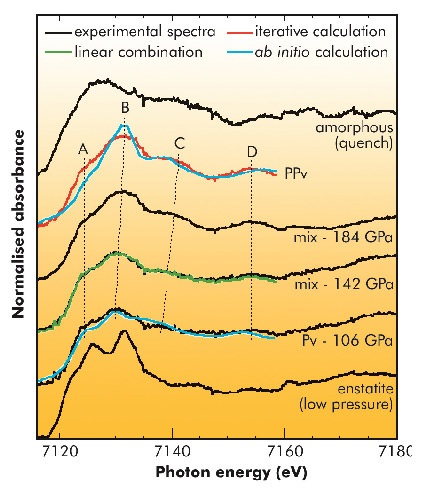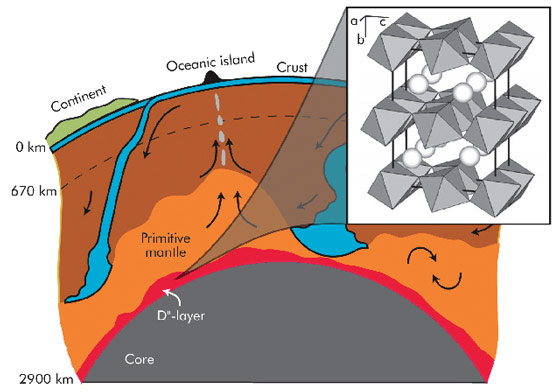- Home
- Users & Science
- Scientific Documentation
- ESRF Highlights
- ESRF Highlights 2010
- Electronic structure and magnetism
- The deepest phase transition in the Earth's mantle
The deepest phase transition in the Earth's mantle
The D"-layer is a 100-300 km thick layer lying just above the core-mantle boundary at 2900 km below the surface of the earth, under a pressure of ~100 to 135 GPa. In this region, seismic observations provide evidence of heterogeneities in wave propagation and sound velocities. Since the perovskite (Pv) to post-perovskite (PPv) phase transition was discovered for MgSiO3 [1], various authors attempted to explain all peculiar seismic features on the basis of this transformation. Indeed, the local structure is quite different in these two phases; the PPv is layered (Figure 88), which enhances significantly its elastic anisotropy, and could help to explain the seismic heterogeneities [2]. However, most of the previous experimental investigations of the Pv to PPv transition mechanism suffer from the limitation that the MgSiO3 composition is too simple. When more significant mantle compositions were investigated (i.e. the composition (Mg,Fe)(Si,Al)O3), the chemical analyses were only performed ex situ on samples recovered at ambient conditions. In the present work, we investigated the mineralogical content and the Fe distribution in various geological samples in situ at high pressure and temperature using tandem analyses of X-ray absorption spectroscopy at the Fe K-edge (ID24) and X-ray diffraction (ID27). These techniques permit the phase relations between the minerals to be determined for bulk samples, in contrast to the thin films that were analysed in previous studies. Pressures up to 180 GPa were obtained using diamond-anvil cells, exceeding the pressure of 135 GPa found at the core-mantle boundary. YAG laser heating was used to reach temperatures of more than 3000 K.
Synthesis of the Pv and PPv grains was carefully monitored using X-ray diffraction, for variable heating duration and temperatures. The sharpness of the Bragg lines and occurrence of a multitude of small spots on the 2-dimensional X-ray pattern indicate efficient atomic diffusion at the scale of the grain size and quasi-equilibrium crystallisation of the silicate phases. The diffraction patterns reveal the presence of two crystalline phases, Pv and PPv, up to the maximum pressure investigated. Relative proportions of the different minerals were quantified based on Rietveld refinements. We then performed Fe K-edge XANES on the same samples in order to retrieve the Fe coordination site and thus the preferential Fe distribution between Pv or PPv phases (Figure 89). Combined with PPv fractions determined using X-ray diffraction, we calculated the Fe-partition coefficient between the two phases.
 |
|
Fig. 89: X-ray absorption spectra recorded at the Fe K-edge as a function of the synthesis pressure (black lines). Experimental data are compared with calculations (coloured lines). XANES spectrum of the enstatite starting material (lowest) and quenched amorphous (highest) are shown for comparison. The features B and C shift significantly with increasing pressure while A and D remain unchanged. This is associated to changes in the Fe local structure when the Fe environment changes progressively from Pv to PPv with increasing pressure from 106 to 184 GPa. |
Our results show that the main PPv phase is depleted in Fe, compared to the Pv phase. Also, we report the proportion and composition of each mineral in the P-T conditions of the D"-region. These results are significant for our interpretation of geophysical data. Fe and Al produce a progressive phase transition from Pv to PPv, in contrast with pure MgSiO3. This progressive transition mechanism is incompatible with the sharp seismic features reported for this mantle region. Thus, more complex models are required that include additional sources of chemical heterogeneity. Furthermore, the occurrence of a PPv-phase with a minimum Fe-content has two major implications: (i) it should enhance the radiative thermal conductivity in the D"-layer, since Fe-free minerals are generally transparent to visible light. This can induce a much higher temperature in the lowermost mantle; (ii) the FeO activity in the mantle is enhanced at the core-mantle boundary, as evidenced by a FeO content up to ~0.30 mole percent in ferropericlase. Thus, FeO should diffuse to the outer core, with a concomitant loss of FeO in the lowermost mantle. This can affect the density of the material located in the D"-layer and can induce unstable dynamical behaviour in this region.
Principal publication and authors
D. Andrault (a), M. Muñoz (b), N. Bolfan-Casanova (a), N. Guignot (c), J.P. Perrillat (d), G. Aquilanti (d) and S. Pascarelli (d), Earth and Planetary Science Letters 293, 90-96 (2010).
(a) LMV, Université Blaise Pascal, Clermont-Ferrand (France)
(b) LGCA, Université Joseph Fourier, Grenoble (France)
(c) SOLEIL, Gif-sur-Yvette (France)
(d) ESRF
References
[1] M. Murakami, K. Hirose, K. Kawamura, N. Sata and Y. Ohishi, Science 304, 855 (2004).
[2] N. Guignot, D. Andrault, G. Morard and M. Mezouar, Earth and Planetary Science Letters 256, 162 (2007).
[3] Derived from L.H. Kellogg, B.H. Hager and R.D. van der Hilst, Science 283, 1881-1884 (1999).




